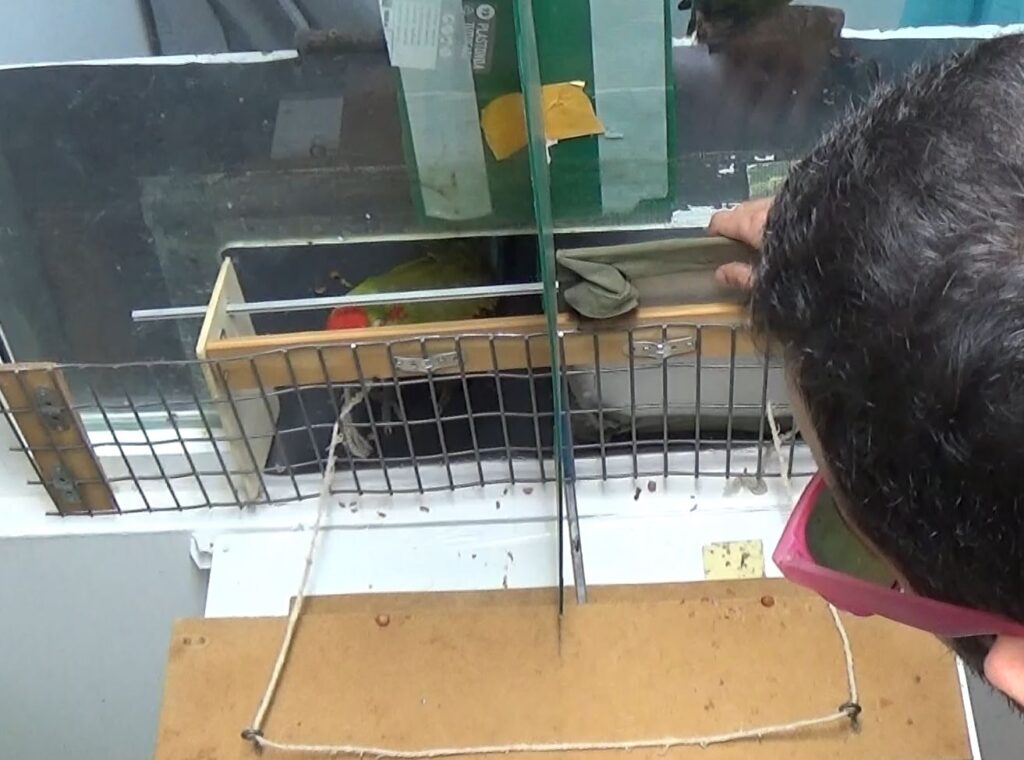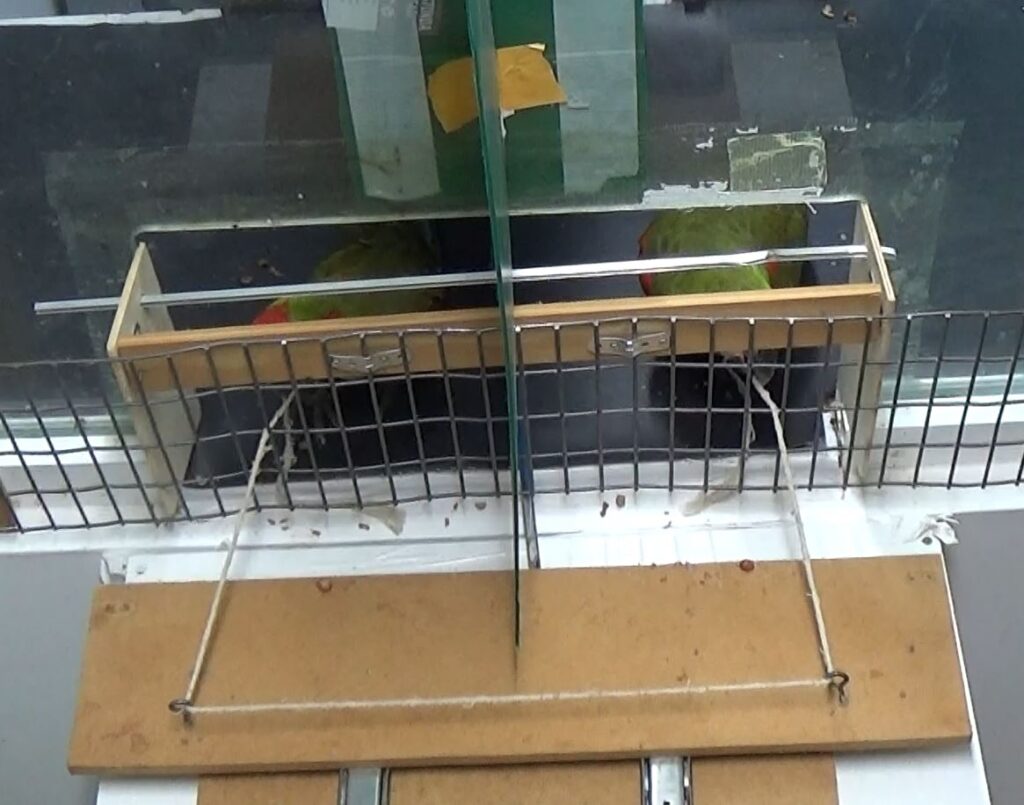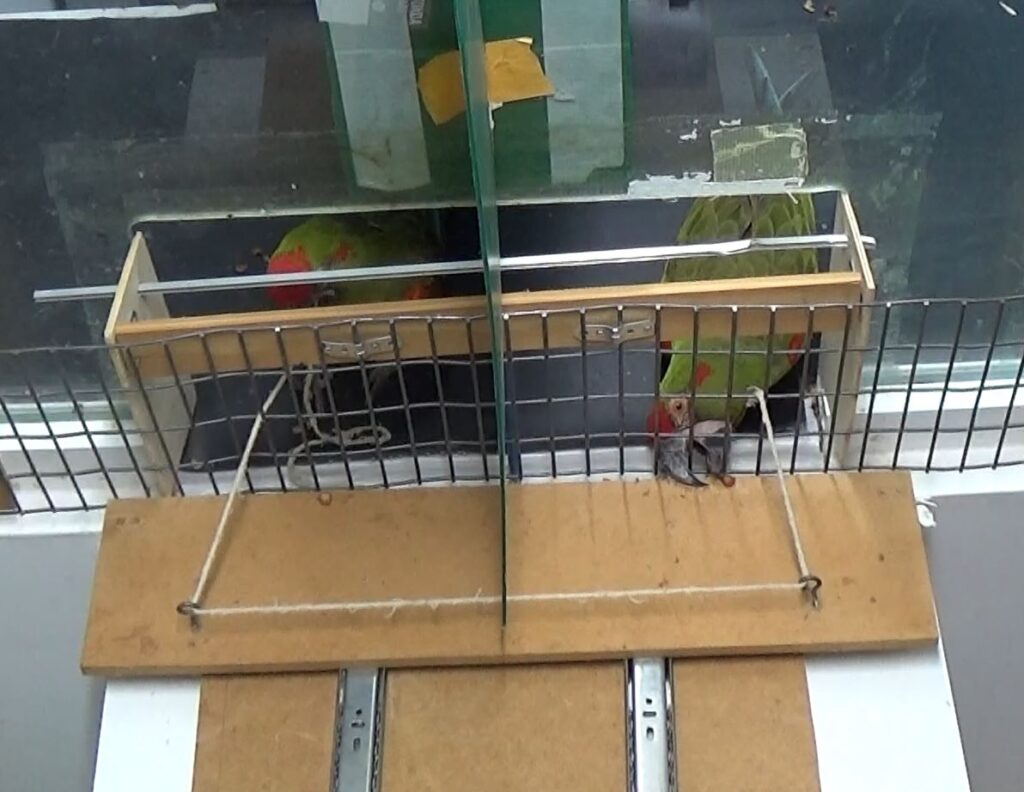In this study, I assessed whether red-fronted macaws are able to understand the need of a partner to solve the loose-string cooperative task through pulling the string simultaneously, also considering their affiliation. I wanted to compare the differences between affiliative and agonistic dyads to elucidate if their social relationship affects their performance, as has been shown in humans, capuchin monkeys (Cebus apella), and ravens (Corvus corax). Red-fronted macaws of the present study successfully solved all four conditions of the loose-string paradigm. Even though the number of successful trials was not equally high for all conditions, in all cases the macaws performed significantly above chance level, similar to other parrots’ species such as the peach-fronted conures. Thus, the results show that Ara rubrogenys can understand, at least partially, the need for a partner to succeed in this cooperative task. This aligns with my hypotheses since this species lives in challenging environments. where having complex social groups and cooperating might be beneficial in coping with them.

The blue-throated macaw, the only macaw species studied with the loose string paradigm until now, successfully solved the task, however, they were unable to understand that they needed to wait for their partner in the delayed conditions, in which the number of successful trials decreased. In contrast to the blue-throated macaw, the red-fronted macaws of the present study did not show any significant decrease in the number of successful trials in the course of the experiment, remaining stable even in the blind delayed condition. These results suggest that the socio-ecological pressures acting on the red-fronted macaw, which are more challenging than the blue-throated macaws´ habitat, might have a positive influence on their cooperative behaviours.
The comparison of the affiliative and agonistic dyads of red-fronted macaw performance shed light on their social preferences and whether their social bonds or partner identity positively affect their cooperative behaviour. In contrast to other species that showed a positive effect of the affiliation towards cooperative behaviours my results showed no significant differences between agonistic and affiliative dyads for the cooperative and the blind conditions, similar to findings reported in blue-throated macaws. Nevertheless, I found significant differences in the blind delayed condition, where the affiliative group showed a higher number of successful trials. One possible interpretation of these findings is that the birds did not understand the need of a second individual and instead applied some strategies that allowed them to successfully complete the task, conditioning their behaviour as some primates do.
The delayed condition was a pre-requisite to move on to the blind and blind delayed conditions. The number of trials to reach the criterion of doing 16 correct trials within the last 20 was not fixed for all dyads, so it could not be used to compare either with other conditions or to assess the success rate in a determined number of trials. Thus, this condition was used to assess if there were significant differences between the number of trials needed by the agonistic and affiliative dyads needed to reach the criterion. The results of the dyads, in which both participants were doing the experiment for the first time showed that the mean number of trials needed for the two affiliative dyads to reach the criterion was significantly lower than the one of the agonistic dyads. This finding aligns with the hypothesis that having an affiliative partner makes the dyad understand faster the need of coordinating their actions. However, the sample size in the present study was too small to draw any general conclusions, so it would be necessary to have more dyads that had never experienced the loose-string paradigm before. Furthermore, when looking at the results of all dyads it appears that, in general, both agonistic and affiliative dyads where both or at least one member had already gone through all conditions previously, were more likely to need fewer trials to reach the criterion. Thus, the parrots showed that they can coordinate with new partners within fewer trials when repeating the experiment.

As red-fronted macaws are known to have a wide range of vocalizations with different acoustic features depending on the context in the wild, they were also expected to vocalize and communicate during the experiment, and even more specifically in the successful trials for the two conditions where they were visually isolated from each other as it was found for the peach-fronted conures. Contrary to my predictions, the parrots did not vocalize in this experiment. The fact that the red-fronted macaws succeeded in the loose-string task even with no vocalizations suggests that something allowed them to still cooperate and succeed in these conditions. The red-fronted macaws solved the delayed condition in a similar way than the blue-throated macaws for the same task by simply going straightforward and pulling the string simultaneously. However, the results of the blind delayed conditions provided interesting results indicating that, in general, the parrots were not simply following the rule of pulling once the string was available.
When analysing the videos, I found that, in contrast to the conditions where the red-fronted macaws could see each other, they coordinated their actions by relying on different cues or strategies in order to succeed. It is possible that the birds knew that a partner was present by hearing them when biting the mesh of the setup or because both partners were brought to the testing chamber in the same cage. Nevertheless, some birds were just failing by pulling the string without waiting for their partner. However, other individuals used to wait until they heard a partner biting the mesh through which the string was fed or waited until they noticed the string was moving, so they responded according to these cues in order to succeed. In addition, a third strategy that I named the “fishing rod effect” was performed by the birds that scored the highest percentage of success. This strategy took place when the first bird having access to the string walked straightforwardly and started to carefully chew and play with it until they felt tension coming from the second bird pulling from the other side and responding consequently. Some authors claimed that the cooperative tasks could be solved using simple behavioural strategies rather than understanding the need for coordinated actions with a partner, which is supported by the present study.

Similar to Keas and peach-fronted conures, the socio-ecological pressures might also shape the capacity of cooperating and developing effective strategies for the red-fronted macaws. My results partially support the hypothesis that the socio-ecological conditions of Ara rubrogenys might predispose it for cooperation as suggested by Seed et al. (2008). However, it needs further studies to clarify that it is not due to the individual learning capacity of the species.
Conclusion
I found that red-fronted macaws are able to solve the loose-string task. However, the results also show that the task can be solved without the understanding of the need for a partner and that the success in the task can be explained by applying alternative strategies. However, the performance of Ara rubrogenys in this task was better than that reported in Ara glaucogularis and more similar to those species that are considered to understand cooperation. To elucidate if this species really understands the mechanisms that underlie cooperation further studies using the loose-string paradigm varying the protocol to try to avoid associative learning or the use of different paradigms are needed to assess whether cooperative behaviours of Ara rubrogenys differs from other macaws species.